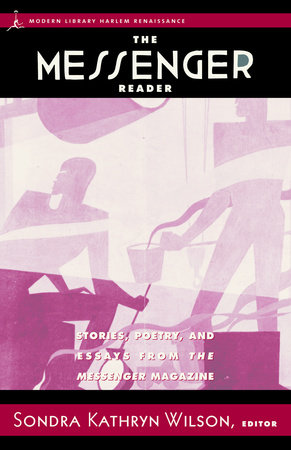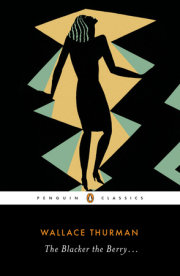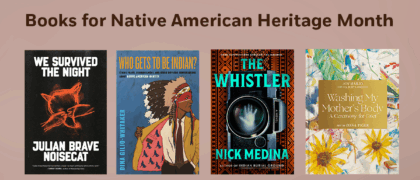Introduction
IF WE MUST DIE
If we must die--let it not be like hogs Hunted and penned in an inglorious spot, While round us bark the mad and hungry dogs, Making their mock at our accursed lot If we must die, let us nobly die, So that our precious blood may not be shed In vain; then even the monsters we defy Shall be constrained to honor us though dead.*
In his poem "If We Must Die," Claude McKay embodies the new spirit and new self-confidence that was flourishing among black intellectuals and writers shortly before the advent of the Harlem Renaissance of the 1920s. This newfound intellectual and cultural freedom owed much to the eloquent editorials in The Messenger. Founded by A. Philip Randolph and Chandler Owen, the New York-based journal first appeared in 1917 for the express purpose of promoting a socialist movement.
Born in Crescent City, Florida, Randolph moved to New York around 1906. After studying at the City College of New York, he became active in the socialist movement. While he was editor of The Messenger in 1921 he made an unsuccessful bid for the office of secretary of state in New York on the socialist ticket. During The Messenger's final years, he abandoned his militancy and devoted more of his efforts to organizing the Brotherhood of Sleeping Car Porters. Messenger cofounder Chandler Owen was born in Warrenton, North Carolina, in 1889. After graduating from Virginia Union University, he moved to New York, where he met A. Philip Randolph, and joined the Socialist Party in 1916. Randolph and Owen were the key figures of The Messenger's editorial team, and their inner circle included W A. Domingo, George S. Schuyler, Theophilus Lewis, William Colson, and J. A. Rogers.
The Messenger was published sporadically during its early years because of meager funding, the First World War, and printers' strikes. It was not published on a consistent basis until 1921, and in 1928 the magazine folded permanently. During its eleven-year run, the journal boasted of being "the only magazine of scientific radicalism in the world published by Negroes."
In this Introduction, I want to explain The Messenger's role in the evolution of the Harlem Renaissance. The magazine's poems, short stories, reviews, and essays presented here illustrate its function as an intellectual and cultural outlet for black artists. These writings resonate with the new type of black militancy The Messenger helped to produce. I hope to make evident how this spirit of rebellion helped to engender the Harlem Renaissance.
Noted scholar David Levering Lewis wrote that "The Harlem Renaissance was a somewhat forced phenomenon, a cultural nationalism of the parlor, institutionally encouraged and directed by leaders of the national civil rights establishment for the paramount purpose of improving race relations." Writer Arna Bontemps divided the literary movement into two phases. Phase one (1921 to 1924) was the period of primary black propaganda. The Crisis, Opportunity, and The Messenger magazines were the most important supporters of phase two, (1924 to 1931), which eventually served to connect Harlem writers to the white intelligentsia who had access to establishment publishing entities. This relationship proved essential in promulgating the Harlem Renaissance. (Tbe Crisis Reader and The Opportunity Reader, two previous volumes in this series, include discussions of those magazines' roles in the development of the Harlem Renaissance.)
After the First World War, gifted black writers such as Arna Bontemps, Langston Hughes, Claude McKay, Wallace Thurman, and Zora Neale Hurston gravitated to Harlem. By this time there were more African-American journalists, dramatists, poets, composers, intellectuals, and actors with international recognition there than in all other American cities combined. In spite of this diverse collection of talent, barriers based on racial prejudice caused black writers to be treated like pariahs in the white publishing world. And, because most white publishers believed African-American writings were substandard, blacks had often been reduced to publishing either with obscure or dubious publishing outfits or by using their own funds. This opinion, according to David Levering Lewis, was evidenced by the fact that only six significant literary writings by African-Americans had been published between 1908 and 192 3: Sutton Grigg's Pointing the Way (1908), W E. B. Du Bois's The Quest of the Silver Fleece (1911), James Weldon Johnson's critically acclaimed The Autobiography of an Ex-Colored Man (1912), Du Bois's Darkwater (1920), Claude McKay's Harlem Sbadows (1922), and Jean Toomer's Cane (1923).
The postwar influx of black intellectuals and artists into Harlem coupled with a lack of outlets for their work meant that The Messenger, like the Crisis and Opportunity magazines, became a literary springboard for nascent black writers.
The Messenger's contribution to the development of the Harlem Renaissance is not as obvious as that of the NAACP's Crisis magazine and the Urban League's Opportunity magazine. This may be because The Messenger was not united with a civil-rights organization, but rather was confederated with a political philosophy of resolute socialism. Moreover, The Messenger didn't have as strong a literary inclination as did the NAACP's and the Urban League's house organs. At the NAACP, this was evidenced by the literary and intellectual works of four brilliant black writers on staff who shared the strong conviction that the power of literature and art could diminish racial prejudice: James Weldon Johnson, W E. B. Du Bois, Walter White, and Jessie Fauset. These NAACP officials were already leading literary figures by the early 1920s. Likewise, the Urban League's director of research, Charles S Johnson, was also the editor of Opportunity. Johnson was "the farsighted manipulative- editor ... trained as a sociologist but sensitive to the power of the arts."
The Crisis and Opportunity instituted the famous literary-contest award dinners that offered cash prizes to inspire and encourage cultural and intellectual efforts among black writers. It was these contest ceremonies that worked so successfully to connect the black literati to downtown white patrons and publishers. It is likely that the well-organized stratagems of The Crisis and Opportunity accounted for these publications' perceived predominance in the promotion of black literature and art. Particularly in its early issues, The Messenger unequivocally made socialistic economics and politics a priority over culture. Nonetheless, by the mid-1920s, it was devoting considerable space to literary writings. Consequently, The Messenger was discontinued in 1928, during the height of the Harlem Renaissance. In spite of its turbulent history, The Messenger proffered an essential radical dimension to African-American social and political thought. Moreover, it was the singular black civil-rights journal that could boast having the best black drama critic on staff in Theophilus Lewis.
The Messenger called for a brand of socialism that would emancipate the workers of America and institute a just economic system. Randolph and Owen believed that centuries of capitalism had perpetuated the existing system, which disenfranchised both black and white workers, and they conceived the idea of using unions as a means to achieving a smooth and painless socialist revolution. Their goal was to unionize American workers, then entice them to become members of the socialist party.
A look at the journal's advertisement space, which was dominated by powerful socialist groups, reveals its primary funding sources. According to Wallace Thurman, a one-time contributing editor for The Messenger in the mid-1920s, these funders may have influenced its philosophy. He noted that the magazine "reflected the policy of whoever paid off best at the time."
Early on, The Messenger editors were driven in their competition with The Crisis to be the most radical and uncompromising journal for black Arnerica. WE.B. Du Bois, editor of The Crisis and the most prominent black intellectual of his time, was acrimoniously pounded by the socialist publication for what the editors believed to be his wrongheaded policies. In their stinging editorials, Tbe Messenger accused the NAACP of espousing an inconsistent policy on segregation. Well established as proponents of antisegregation in all phases of American life, the NAACP nevertheless endorsed a policy of segregation for military units during World War I. The leading civil rights organization could not articulate an acceptable rationale for their contradictory support of self-segregation. The Messenger made the argument that black participation in the war was too high a price to pay to a racist nation that did not deserve such loyalty. Furthermore, a Messenger notice that was unmistakably directed toward the leaders of the NAACP stated: "our aim is to appeal to reason, to lift our pens above the cringing demagogy of the times and above the cheap, peanut politics of the old reactionary Negro leaders."
The Messenger declared firmly that the "new style Negro" would "no longer turn the other cheek." The publication even applauded the African-Americans who had fought back in the nation's capital and in Chicago when racial upheavals had occurred there during 1919. This "new style Negro" was determined to make this nation safe for black people. Under the influence of socialism, W. A. Domingo opined that the "new style Negro" cannot be subdued with political spoils and patronage into a false sense of security. But more than that, race leaders must support a labor party and reject capitalism. Black men must fight back, he argued. Social essays presented in this volume like "The Failure of Black Leadership," "Socialism the Negroes' Hope," and "If We Must Die" further delineate The Messenger's concept of "the new style Negro."
When black men returned from the war having participated in its moral crusade for international democracy, they realized that the only way to claim the mantle of freedom for African-Americans was to fight back physically, culturally, and intellectually. The war experience proved to be a valuable lesson in democracy, and this indoctrination translated into a new type of militancy in race relations.
The participation of blacks in the war coupled with The Messenger's radicalism gave many of them a renewed spirit and a feeling of power. This metamorphosis sparked a social and literary upsurge. The Messenger's connection to the Harlem Renaissance was not forged systematically but rather was a product of African-Americans' response to zealous radical voices crusading for socialism. Though most African-Americans rejected the journal's philosophy of socialism, many race leaders accepted the major elements of its message.
In 1925 Philosopher Alain Locke, using the theme "new style Negro" extolled by The Messenger, assembled a number of writers to create the critically acclaimed book The New Negro. Filled with poems, short stories, essays, and plays, the volume was described by Locke as the first fruits of the Harlem Renaissance. The New Negro was "the definitive presentation of the artistic and social goals of the New Negro movement."
The Messenger Reader constructs a narrative that illuminates the cultural and intellectual aspects of black life from 1917 to 1928. In assuming the responsibility of promoting African-American literature and art as a means of diminishing racial injustice, novelist and Messenger editor Wallace Thurman must be credited for publishing many of the works by Harlem Renaissance authors appearing in this volume: the first short stories by Langston Hughes, a series of sketches by Zora Neale Hurston, a short story by Dorothy West, poems by Georgia Douglas Johnson, and Arna Bontemps. Many lesser-known but equally talented writers like Thomas Millard Henry, Irene Gaines, William N. Colson, and Angelina Grimke help to build this story edifying the black cultural movement of the period. This volume also includes the short stories and dramatic criticisms of the undeservedly little-known Theophilus Lewis-called the "literary brains" of The Messenger--who published the most effective and consistent writings on the theater during the Harlem Renaissance.
The Harlem Renaissance of the 1920s symbolizes a flashpoint in American literature. Similar black literary movements, as scholars have predicted, will emerge again and again. This recurrence is significant because with each new play, poem, song, story, and essay by an African American, greater clarity will be given to American culture. This is vitally critical because this nation desperately needs to square itself with its multicultural dilemma, and what better way to accomplish this than through the revelations of great black literature?
EDITOR'S NOTE: The contents of this volume have been reproduced largely as they originally appeared in TbeMessengermagazine. Though some obvious typographical and spelling errors have been silently corrected, most idiosyncrasies of spelling, punctuation, and typography have been preserved.
Copyright © 2000 by Sondra Kathryn Wilson, Editor. All rights reserved. No part of this excerpt may be reproduced or reprinted without permission in writing from the publisher.






